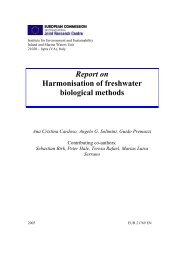Lakes and Watercourses
Lakes and Watercourses
Lakes and Watercourses
Create successful ePaper yourself
Turn your PDF publications into a flip-book with our unique Google optimized e-Paper software.
(in Swedish with English summary). The method of identifying reference<br />
values is explained in each chapter. In general, it may be said that further<br />
systematic studies are needed for most parameters in order to obtain<br />
representative data.<br />
It was proposed in the previous quality criteria for lakes <strong>and</strong> watercourses<br />
(Swedish EPA 1991) that county administrative boards <strong>and</strong><br />
water management associations should compile maps on background<br />
conditions by catchment based on results from earlier surveys <strong>and</strong> studies<br />
of unaffected lakes <strong>and</strong> watercourses or using specified calculation algorithms.<br />
This is still to be recommended <strong>and</strong> would probably allow better<br />
adjustment to local or regional conditions than direct application of the<br />
reference values presented here, which are often regional <strong>and</strong> statistically<br />
based.<br />
Division in type areas<br />
Since available data varies greatly from one parameter to another <strong>and</strong><br />
since various surrounding factors are significant to each parameter, it has<br />
not been possible to classify geographical regions <strong>and</strong> water types on the<br />
basis of principles common to all parameters. The various classifications<br />
are described in each chapter.<br />
References<br />
Swedish Environmental Protection Agency (1991): Bedömningsgrunder<br />
för sjöar och vattendrag (”Quality criteria for lakes <strong>and</strong> watercourses”).<br />
Swedish EPA General Guidelines 90:4.<br />
18















![Accommodation booking form [PDF]](https://img.yumpu.com/39471785/1/184x260/accommodation-booking-form-pdf.jpg?quality=85)

